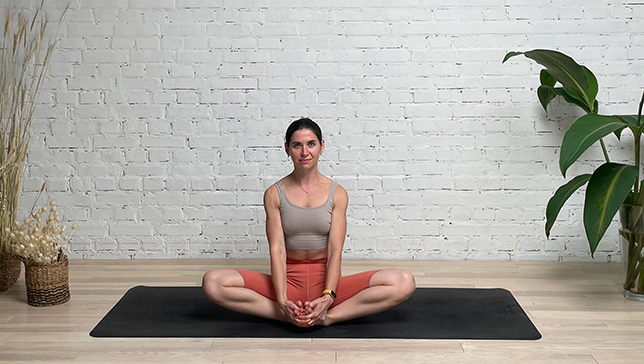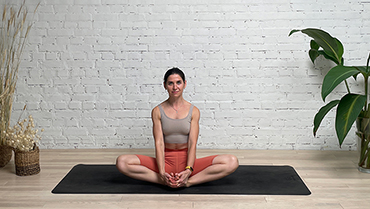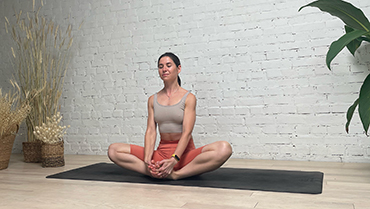Bound Angle Pose - Baddha Konasana

Contents
Bound Angle Pose or Baddha Konasana in Sanskrit (Baddha means ‘bound’, ‘caught’, ‘held’, Kona means ‘angle’, and asana means ‘pose’) is a seated yoga posture that is commonly practiced in many styles of yoga. In other texts, you may find this yoga pose under the name Bhadrasana. The English translation of the Sanskrit term ‘Bhadra’ is ‘virtuous, pure, prudent, excellent, wise.’ and asana means ‘pose’.
Baddha Konasana is a great posture for stretching the inner thighs, groins, and knees, while also opening the hips and improving circulation in the pelvis. It can also help to alleviate menstrual cramps and improve digestion.
This is one of the prominent yoga poses mentioned in the Hatha Yoga Pradipika. Bound Angle Pose is considered a base pose as bound angle pose variations can be derived from this pose.
Bound Angle Pose is also known as Cobbler’s Pose, Butterfly Pose, and Shoemaker pose.
Pose Detail
- Difficulty: Beginners
- By Type: Flexibility Yoga Poses, Hip Opening Yoga Poses, Strengthening Yoga Poses
- Body Position: Seated Yoga Poses
- By Benefit: Yoga Poses For Digestion, Yoga Poses For Periods, Yoga Poses For Sciatica, Yoga Poses For Sleep, Yoga Poses For Stress Relief
Step-by-Step Instructions
Benefits and Contraindications
Stimulates abdominal organs, ovaries and prostate gland, bladder, and kidneys.
Stimulates the heart and improves general circulation.
Stretches the inner thighs, groins, and knees.
Helps relieve mild depression and anxiety.
Soothes menstrual discomfort and sciatica.
Helps relieve the symptoms of menopause.
Therapeutic for flat feet, high blood pressure, infertility, and asthma.
Consistent practice of this pose until late into pregnancy is said to help ease childbirth.
Traditional texts say that Baddha Konasana destroys disease and gets rid of fatigue.
Groin or knee injury: Only perform this pose with blanket support under the outer thighs.
Photo poses in different angles


Modifications And Props For Beginners
Although the Bound Angle Pose is a yoga pose for beginners, you may need some props to properly align it.
- Blanket under the hips: If you find it difficult to sit comfortably in this pose, you can fold a blanket and place it under your hips for support. This will help elevate your hips and take pressure off your lower back.
- Bolster or pillow behind the back: If you have tightness or discomfort in your lower back, you can place a bolster or a pillow behind your back for support. This will help you sit up straighter and maintain the length in your spine.
Useful Tips
The anatomical structure of the hip joints can also influence and limit mobility in this position.
Keep in mind that in Bound Angle Pose we work with hip joints rather than with knees.
If practitioners cannot bring their knees to the floor in this pose, ask them to move their feet away from their pelvis. Practitioners’ legs should form a diamond shape. Sitting like that will help practitioners to work with their hip joints’ mobility and protect their knees from injuries.
Bound Angle Pose Anatomy
Bound Angle Pose Baddha Konasana is a hip-opener pose. It stretches the groin, adductors (inner thighs), and knees and strengthens the pelvic floor and psoas muscles as well as hip flexors. As the hip flexor muscles loosen up, one is able to lengthen and decompress the spine as well. In addition to this, the Bound Angle Pose also helps one access the thoraco lumbar fascia, which is correlated to piriformis syndrome which causes extreme pain in the lower back region of buttocks, hips, hamstrings, and feet.
Modifications & Variations
- Reclining Bound Angle Pose
- Bound Angle Pose With Blocks
- Half-Bound Angle Pose
- Bound Angle Pose Feet Thighs Partner
- Revolved Butterfly Pose Hand Variation
- Half Butterfly Pose Variation Forward Bend
- Upward Star Pose Feet Arms Overhead
- Revolved Bound Angle Pose